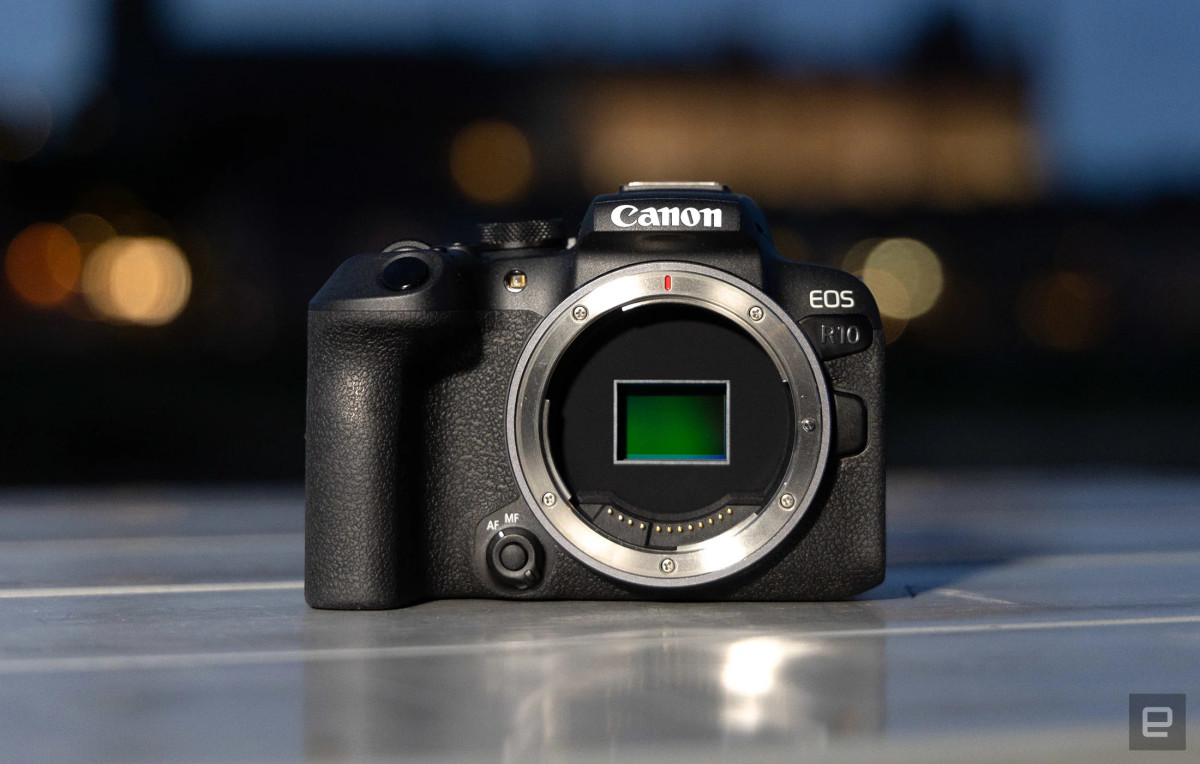In comparison to its predecessors, the EOS R10 is a worthy upgrade. The Digic X processor in the Canon EOS R10 allows for its state-of-the-art focusing technology and excellent burst shooting for the price. This camera has a continuous shooting rate of 15 fps and a Dual Pixel CMOS AF II.
Design
Due to the fact that it weighs a total of only 429 grams, it is extremely portable. Even while utilizing most lenses, handling is made simple thanks to the device’s deep grip. The viewfinder has a very meager magnification of 0.59x, and there is no protection.
Everyone who has worked with a Canon DSLR in the past will have no trouble getting acquainted to the Canon EOS R10. It’s a very lightweight device. The Canon EOS R10 has a mode dial on the top of the camera. Additionally, the camera has front and rear command dials, a multi-function button, and a button to capture video. It is a wonderful touch that Canon has included a multi-purpose accessory shoe that can charge and carry data to peripherals like shotgun microphones. In terms of design, you have access to a touchscreen that is fully moveable, foldable, and articulatable. Additionally, there is an AF joystick. It has a strength that is comparable to that of the R10, and its autofocus system has 651 AF points. One of the issues with the Canon EOS R10 is that the camera has a viewfinder that is fairly cramped. The electronic viewfinder (EVF) has a magnification of 0.59x, which is quite low. There is only one slot for a UHS-II card. Despite the fact that the EOS R10 has a microphone input, you won’t be able to listen to what’s being recorded via headphones due to the lack of a headphone connector on the camera.
Price and Availability
Currently on sale for $979 (body only) Additional options include two lens kits. Slightly less expensive than the Fujifilm X-S10
At this time, the Canon EOS R10 may be purchased in a range of different bundles, with the body-only model being the most economical option with a price tag of $979. Other bundles include a variety of lenses, flashes, and other accessories.
Features and Perfomance
Can reach rates of 15 fps momentarily while using the mechanical shutter. Electronic shutter results in a faster peak speed, but it also places constraints on the rolling shutter.
When compared to other cameras in its price range, the autofocus tracking with this one is excellent. The EOS R10’s ability to combine excellent focusing with quick burst shooting is one of its many strengths. The excellent EOS R10’s mechanical shutter speed is 15 frames per second and its electronic shutter speed is 23 frames per second. The Canon EOS R10 is one high-end camera that features the Dual Pixel CMOS AF II autofocus system. It’s astounding in how well it works and how simple it is to operate. For such a low-priced camera, the 4,053 AF points are quite outstanding, and switching between them is a breeze thanks to the AF joystick. Due to its short battery life and lack of in-body image stabilization, the Canon EOS R10 lags behind several competitors. When compared to other mirrorless cameras, the EOS R10 has respectable battery life. If the EOS R10 doesn’t identify any eyes, it will switch to a face or body AF mode, which is a significant improvement over prior focusing systems. By tracking the subject you lock onto across the whole frame, the EOS R10 surpasses competitors when continuous AF is activated.
Specifications
Image and Video Quality
The image quality is impressive. Captures 4K/30p footage that is uncropped and oversampled from 6K. Color graders lack a headphone jack and a “flat” log video profile.
While the EOS R10’s new 24.2MP sensor is impressive, it lacks a rear-illuminated electronic viewfinder (BSI). In BSI sensors, the electronics are placed behind the light-sensitive photosets, rather than in front of them, which often results in less noise and higher image quality. Oversampled from the sensor’s native 6K resolution, the EOS R10 can shoot uncropped 4K/30p video, giving it impressive video capabilities. The camera’s 4K/60p mode isn’t quite up to this standard, but it’s still a great asset for vloggers and YouTubers. The ability to slow down 60p mode to half speed is a huge benefit, since it enables some very breathtaking scenes. There are a variety of video choices beyond the regular 1080p/120p slow motion and ‘HDR PQ’ mode. As the EOS R10 has no headphone jack and a “flat” log profile, it is impossible to listen to what you’re recording when out in the field.
Verdict
The Canon EOS R10 offers some fairly sophisticated specifications in a body that is light, inexpensive, and user-friendly for new photographers. It is a wonderful value proposition. You can achieve some pretty spectacular outcomes with this camera if you know what you’re doing with it; nevertheless, even if you have no idea what you’re doing, using this camera will help you build your talents. It is a terrific all-purpose camera, with powerful stills specs and impressive video capabilities; however, if you want to shoot 4K 60p, this is probably not going to be the best vlogging camera for you to use. This content is accurate and true to the best of the author’s knowledge and is not meant to substitute for formal and individualized advice from a qualified professional. © 2022 Maina Wilson






